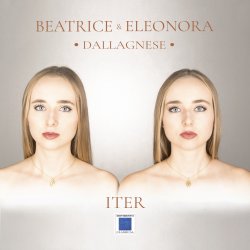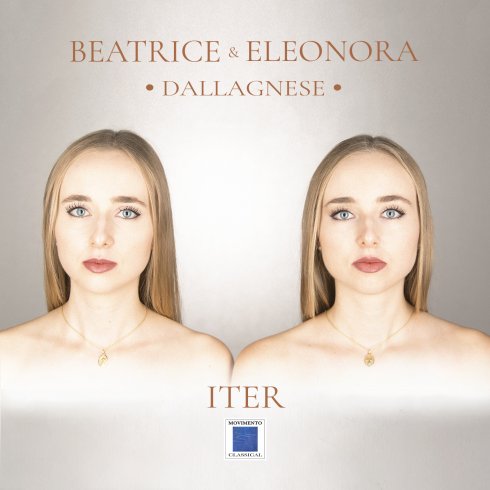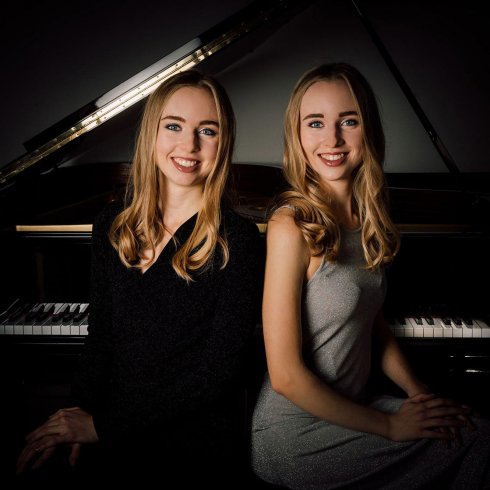

ITER
Four hand plano: a household concem.
"Performing piano duets with two people playing at a single instrument [avoids] the inconvenience of overcrowding a room." With these words. in 1777 the music historian and compose, Charles Burney introduced his own Four Sonatas or Duets far Two Performers on One Piano Forte or Harpsichord. one of the very first works far piano four-hands (or keyboard in generai) ever published. As a matter of fact. some repertoire far this unusual duo did already exist. but it was largely confined to a private use and had never reached the publishing houses. The popularity of the piano four-hands, by no coincidence, grows side by side with the rise of the bourgeoise class and the many soirées organized by the wealthiest and most accomplished families as a gathering of the best of the contemporary society and its intellectuals. In such gatherings, a prominent raie was played by artists themselves: men of letters, painters, musicians, these events gathered them ali, friends and rivals alike, regardless engaged in heated arguments or friendly chats. The salon became a piace of sociality, where both regulars and foreigners were welcomed. lt was common practice far great writers or poets to take advantage of these gathering to present their latest works to the public, and so did composers and musicians, who in these occasions made new acquaintances aimed to obtaining new commissions, students, and artistic engagements. These crowded rooms, as shown by the many paintings of the period, were often packed with well-dressed gentleman and gentlewomen, who carne there to discuss or listen. lt goes without saying that an orchestra could hardly find enough room, there. At most, in the more spacious salons, ensembles up to a quinte! or sextet, usually of strings, could be found. One thing, however, was almost never missing: a piano. The vast majority of the piano four-hand repertoire thus originateci from and far these contexts, and unsurprisingly consisted mainly of transcription. Since there were stili no media far sound reproduction to allow to listen, repeat and possibly even analyse the latest musical works, it was necessary far them to be 'limited' to the household. The consequence was that of almost every work, be it a symphony or a string quartet, publishers would immediately prepare additional versions far piano four-hands. Later on, in addition to transcriptions, a vast repertoire of compositions originaliy conceived far piano four-hands was developed, and in severa! cases was then transcribed far orchestras, with an inversion of origins. Such compositions rapidly became successful: suffice it to say that, if in 1777 Burney was having his pieces published and presented as an utter novelty, 51 years later death carne far one of the greatest composers of music far piano four-hands: Franz Schubert.
Schubert's fantastic storms.
Only few composers can be more closely linked to the salon than Franz Schubert (1797-1828). Born and raised in Vienna, Franz took part in the domestic string quartet from anearlyage. Domestic musical practicewas common- place, so it is no coincidence thai Schubert's first composition, dating back to when he was only 13 years old, was a Fantasy in G major far piano four-hands, which today appears as opus 1 in the Deutsch catalogue (D 1). Funnily enough, one of his last works was also a Fantasy far piano four-hands, brought to completion in Aprii 1828, the very same year of the premature death of the 31-year-old Schubert. Composed and immediately put aside, aver the years the Fantasy in F minor D 940 would become one of his most appreciated works. lts structure is a fascinating union between the four-movement sonata and the Charakterstock, a character piece with a free, fan- tastic, and not infrequently improvisational sian!. Also, the very same thematic materiai circulates freely throughout the piece, weaving the fabric thai holds the flow of these four movements (Allegro molto moderato, Largo, Allegro vivace, Con delicatezza), a fabric thai is rendered with even more liquid ease than Schubert's previous experi- ment in this hybrid form, the famous Fantasy in C major Wanderer" far solo piano. Compared to the "Wanderer", however, in the Fantasy in F minor Schubert uses a more subtle writing style, made up of contrapuntal inlays and dense dialogue, whose markedly symphonic majesty is not meant to reach the virtuosic and chirpy flair of the earlier Fantasy in C major. More akin in character to the "Wanderer" is the Allegro in A minor, composed in the month of May immediately following the completion of the F minor Fantasy. Passed into the annals of history with the nickname of "LebensstOrme" (in English, "the storms of life"), assigned to it by publisher Anton Diabelli at the time of publication, this Allegro indeed has a stormy feel to it, right from the peremptory beginning that tickles the listener's imagination. lt is not by chance that the storm, that sublime moment during which man is at the mercy of natural forces, is a recurring topos in Romantic poetry and literature, which Schubert, an avici reader, knew very well. One would be wrong, however, to reduce this mighty Allegro to a mere sketch of program music, of extra- musical inspiration. Effectively, what we are presented with is a long and complex piece in sonata lorm, which could easily find a piace in one ol Schubert's great piano sonatas. Despite the numerous majestic repetitions in the Allegro, its character is markedly less symphonic when compared to the Fantasy in F minor. We can legitimately wonder whether Schubert had thought ol this piece as a proper first hall ola never-to-exist piano lour-hands sonata, modelled alter the great sonata in C major composed in 1824.
Johannes Brahms' private diary
The very same tradition ol domestic musical performances, as well as the lascination with the pianistic writing that aims toward orchestrai breadth, is the common denominator between Johannes Brahms (1833-1897) and Schubert. The symphonic dimension we find in the Hungarian Dances, unsurprisingly popular in the various orchestrations, emerges clearly already in the Variations op. 23 on a theme by Schumann, composed in 1861. The Variations are not only conceived lor a mere domestic performance, but are tailor made lor Brahms himself and Clara Wieck, Schumann's widow. This work is of explicitly autobiographical inspiration. lts theme is exactly the "Geister-Thema", the "theme ol the spirits", which takes its name from a vision Schumann had in 1854. On this theme, Schumann himself developed a cycle of variations that then became his last piano work. Brahm's tribute carne five years alter Schumann's death and consisted of a reworking ol the composer's last theme that found piace in this amazing yet cryptic cycle. lts intimate nature is made manifest by the last Variation, a bright march, over which Schumann's theme is reinserted, filled with heavenly sweetness, in a moving farewell. A completely different spirit animates the whimsical Hungarian Dances. Brahms wrote 21 of them, all originally tor piano lour-hands and destined to reach immense popularity. The first ten Dances were republished in 1869 as the result of Brahms' musical collaboration with the Hungarian violinist Eduard Reményi and their tournées in Hungary. Rather than of Hungarian rnusic, however, we should speak of Gypsy music as heard on city streets rather than in the villages of the Magyar countryside. The result of this inspiration, again drawn from his own private lite, is a cycle of genuinely entertaining Dances, evoking the more playful aspect of piano four-hand pieces, but at the same time managing to blend Gypsy music into Brahms' style. Such uncommon balance is one of the reasons of this work's success and serves as an explanation of a certain Gipsy hue that would accompany Brahms throughout his production, right up to his last compositions. In fact, as early as 1861, Brahms decided to conclude his first Piano quartet exactly by means of a frantic Gipsy-style Rondo: it is quite clear that something of the cheeky nobility and breezy enthusiasm must have resonated in the Hamburg composer's soul.


Eleonora & Beatrice Dallagnese
Beatrice and Eleonora Dallagnese are 23-year-old twin sisters from Oderzo – Treviso (Italy) and they have been studying the piano since the age of 4.
In 2015 they were admitted to the prestigious International Piano Academy ‘Incontri col Maestro’ in Imola where they had studied with M° Stefano Fiuzzi. They are currently attending the courses with Maestros Ingrid Fliter and Boris Petrushansky in solo piano class and with Marco Zuccarini and Nazzareno Carusi in the chamber music class.
In 2018 they graduated at the Conservatory ‘C. Pollini’ in Padua, both with the highest marks cum laude and honourable mention.
They have participated in masterclasses held by Maestros Alberto Nosè, Selma Chicco Hajdin, Gloria Campaner, Federico Colli, Jerome Lowenthal, Natalia Trull, Franco Scala, Andrè Gallo, Avedis Kouyoumdjian, Lilya Zilbertstein, Silver-Garburg duo and Michel Béroff.
In 2022 they have been nominated Yamaha Artists with the following announcement: ‘It’s a great honor for us of Yamaha Piano to welcome the talented Eleonora and Beatrice Dallagnese into Yamaha Artist family, we are sure they will be excellent ambassadors for piano and musical culture, bearers of beauty, poetry, talent and great professionalism.’
In the same occasion, they recorded their first Album.
In the same year they took part at the Schumann’s project organized by Imola Piano Academy, recording some of the composer’s works.
They regularly hold concerts both as soloists and piano duo and they have performed in some of the most prestigious concert seasons such as the ‘Accademia Filarmonica di Verona’ at the University of Verona, ‘Società del Quartetto di Milano’ at Puccini Hall of the G. Verdi Conservatory, ‘Imola Summer Festival’ at Teatro dell'Osservanza, ‘Accademia Filarmonica di Bologna’ at Mozart Hall, ‘Amici della Musica di Padova’, ‘Bartolomeo Cristofori Piano Festival’ in Padua, ‘Festival di Pentecoste’ in Badia a Passignano (Firenze), ‘Circolo di Ave’ in Fermo, ‘Musica con le ali’ in collaboration with Teatro La Fenice in Venice, Oratorio del Gonfalone in Rome, Bocconi University in Milan and ‘Fondazione La società dei Concerti di Milano’.
They have performed abroad at the renowned Wiener Saal in Salzburg, Bruxelles, Montecarlo, Festival de Musique de Menton (France), ISA Festival in Reichenau an der Rax (Austria), Piła Festival (Poland), Łódź (Poland), at the Italian Institute of Culture in Warsaw, at the Theatre of the Italian Institute of Culture in Istanbul and at the Carnegie Hall (Stern Auditorium/Perelman Stage) in New York.
In June 2017, following their victory of the American Protégé Competition in New York, they performed at the Carnegie Hall (Stern Auditorium / Perelman Stage) in New York.
In 2019 they were invited by Maestro Franco Scala, founder and director of Imola Piano Academy, to perform in concert at the Teatro Ebe Stignani in Imola with the presence of the Minister of Education Marco Bussetti and the president of Imola Piano Academy Corrado Passera.
They performed, as soloists, with the Orchestra Sinfonica Abruzzese, the Bacau Philarmonic Orchestra and the Virtuosi Brunensis Orchestra.
Furthermore, they have collaborated with ‘Quartetto Adorno’ and on "Mousiké" project with the pianist Gloria Campaner and the visual artist Natan Sinigaglia.
In the year 2023 they were selected by CIDIM as part of the project to promote young talented pianists in the world.
Some of their concerts have been broadcasted in television channels such as “il13” and on the radio RPL.
Beatrice and Eleonora have taken part in National and International piano competitions both as soloists and in piano duo obtaining 44 first absolute prizes such as: ‘Piano talents’ International Piano Competition in Milan, Concours International de piano à 4 mains in Montecarlo, Cesar Franck International Piano Competition in Bruxelles, International Piano Competition in Treviso, ‘Recondite Armonie’ International Piano Competition, San Donà International Piano Competition and ‘Andrea Baldi’ International Piano Competition in Bologna.
